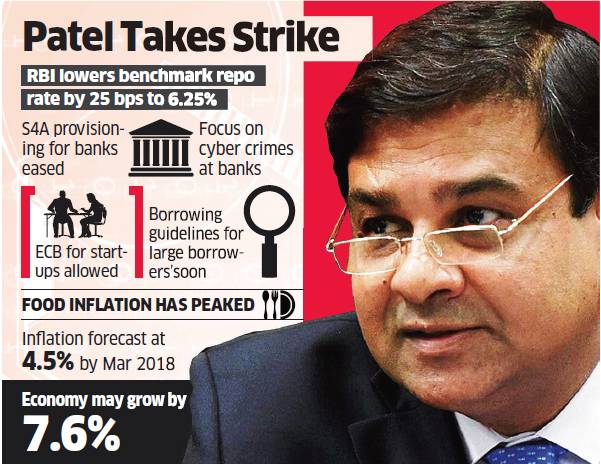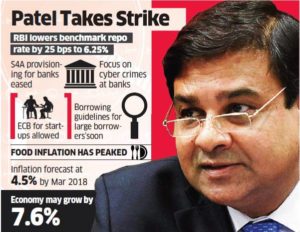In order to ease the inflation, the Reserve Bank of India cut policy rate (repo rate) by 25 basis points to 6.25% from 6.5%.
About Bank Rate :
Repo rate is the rate at which the central bank of a country (Reserve Bank of India in case of India) lends money to commercial banks in the event of any shortfall of funds. Repo rate is used by monetary authorities to control inflation.
- In the event of inflation, central banks increase repo rate as this acts as a disincentive for banks to borrow from the central bank. This ultimately reduces the money supply in the economy and thus helps in arresting inflation.
- The central bank takes the contrary position in the event of a fall in inflationary pressures. Repo and reverse repo rates form a part of the liquidity adjustment facility.
- Bank rate in India is determined by Reserve Bank of India (RBI). It is the rate at which RBI gives loan to commercial banks without keeping any collateral. The RBI also provides short term loans to its clients (keeping collateral) which is called the repo rate. RBI revises this rate periodically. However, there is no predetermined schedule.
The repo rates are changed re-actively depending on the economy. Like other countries, repo rates affect the money flow into the nation’s economy and affect the inflation and commercial banks’ lending or interest rate.The Indian bank rate is 7 %, which is same as the rate for Marginal Standing Facility (MSF)
Bank Rate Reduction :
The Monetary Policy Committee (MPC) all members of policy decided for 25 basis point rate cut.
- This was the fourth bi-monthly monetary policy of the RBI. It was first monetary policy statement after Urijit Patel took over as governor on September 04, 2016.
- On the basis of an assessment of the current and evolving macroeconomic situation MPC decided to reduce the policy repo rate under the liquidity adjustment facility (LAF) by 25 basis points from 6.5% to 6.25% with immediate effect.
 A lower repo rate—the rate at which banks borrow from RBI–would mean households may expect cheaper bank loans to buy houses and goods such as cars, which peak during the festival shopping season in October and November.
A lower repo rate—the rate at which banks borrow from RBI–would mean households may expect cheaper bank loans to buy houses and goods such as cars, which peak during the festival shopping season in October and November.- The BSE Sensex rose 85 points to 28,328 mirroring the stock markets’ heightened expectations about lower rates.
- The government has announced several measures to cool food inflation pressures, especially with regard to pulses. These measures should help in moderating the momentum of food inflation in the months ahead.
- India’s economy grew 1% during April to June, the slowest in 6 quarters, but the RBI and the MPC expect a revival in the coming months boosted by good rains, a pay bonanza for government employees and festive season buying.
- The RBI retained its earlier growth projection of 7.6 percent for 2016-17.
- The momentum of growth is expected to quicken with a normal monsoon raising agricultural growth and rural demand, as well as by the stimulus to the urban consumption spending from the pay commission’s award.



 A lower repo rate—the rate at which banks borrow from RBI–would mean households may expect cheaper bank loans to buy houses and goods such as cars, which peak during the festival shopping season in October and November.
A lower repo rate—the rate at which banks borrow from RBI–would mean households may expect cheaper bank loans to buy houses and goods such as cars, which peak during the festival shopping season in October and November.

